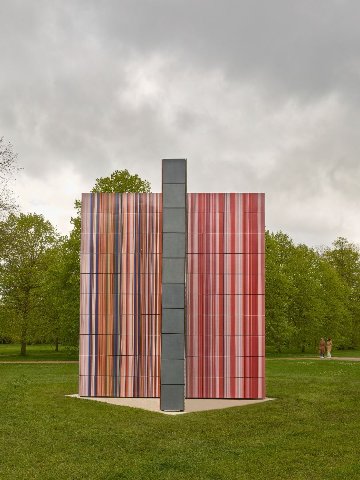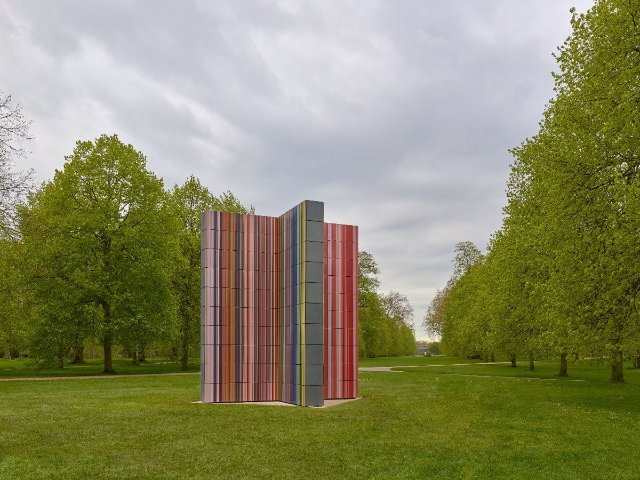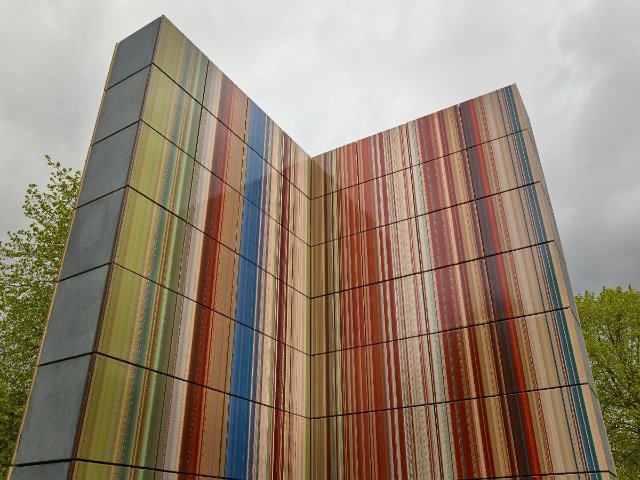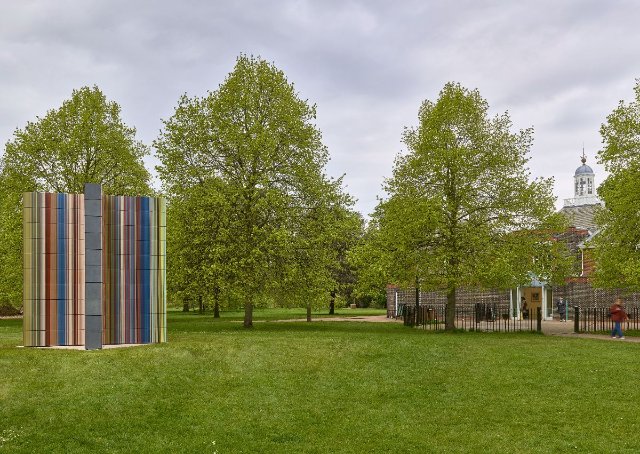STRIP-TOWER by Gerhard Richter
Installed by London's Serpentine Gallery
By: Serpentine - Apr 23, 2024
Serpentine and The Royal Parks unveil a new large-scale sculpture by German artist Gerhard Richter (b. 1932, Dresden, Germany; lives and works in Cologne, Germany). Situated on the plinth at Serpentine South, in Kensington Gardens, STRIP-TOWER (2023) will be staged from 25 April to 27 October 2024. It will be the latest presentation in a long-standing series of remarkable public presentations in The Royal Parks since Serpentine’s foundation in 1970.
STRIP-TOWER (2023) expands on the artist’s continued exploration of painting, photography, digital reproduction and abstraction and self-scrutinising approach that have occupied his practice for over six decades.
Richter began developing his series of Strip Paintings in 2010, inspired by an earlier ‘squeegee painting’ titled Abstract Painting 724-4 (1990). This painting was then photographed. With the support of a software program, the scanned images were digitally manipulated and divided into two strips, then four, eight, sixteen and thirty-two. The vertical strips of the painting were then stretched across a horizontal expanse before being laminated onto aluminum and covered with Perspex. STRIP-TOWER employs a similar method, in which colourful striped ceramic tiles clad two perpendicular panels. The thin vertical stripes form a dense composition where the intersecting panels create a cross section that visitors can also stand within.
Gerhard Richter's artist book Pattern was the first manifestation of this fractal method. It is co published by HENI and Verlag der Buchhandlung Walther und Franz König, Köln and is entirely designed by the artist. The book shows Richter’s experiment of taking an image of his Abstract Painting [CR: 724-4] and dividing it vertically up to 4096 strips. This methodology led to 8190 thinner strips which are then mirrored and repeated. The outcome is 221 patterns which are published on 246 double page images. Pattern is one of many outstanding artist books Richter has produced over the last couple of years such as Wald (Forest) (2008) and EIS (2011), which includes a special layout of the artists stunning photographs of a trip to the Antarctic.
STRIP TOWER builds on Richter’s ongoing interest in the idea of reflections, systems, and repetitions, which could be seen in 4900 Colours exhibited at Serpentine in 2008, with the surfaces of the glossy tiles subtly mirroring the viewer and the surroundings of the Royal Parks.
4900 Colours comprised bright monochrome squares randomly arranged in a grid formation to create stunning sheets of kaleidoscopic colour. The 196 square panels of 25 coloured squares was conceived to be configured in a number of variations, from one large-scale piece to multiple, smaller paintings. Richter developed a version comprised of 49 paintings especially for Serpentine.
4900 Colours in part grew out of Richter’s design for the south transept window of Cologne Cathedral, which replaced the stained glass that had been destroyed during the Second World War. The window, unveiled in August 2007, comprised 11,500 hand-blown squares of glass in 72 colours derived from the palette of the original Medieval glazing. The seemingly arbitrary distribution of colours was generated using a specially developed computer programme. This interest in using chance to define composition was significant in the development of the artist’s concept for 4900 Colours.
STRIP TOWER also continues the artist’s Grid series in 1966 exploring connections with controlled change initiated with the six large, square paintings Cage (1) – (6), (2006). Here, Richter intends to eradicate hierarchy of subjects.
Bettina Korek, CEO, and Hans Ulrich Obrist, Artistic Director, Serpentine, said: “It’s an honour to present Gerhard Richter’s extraordinary work STRIP-TOWER here in Kensington Gardens, an artist Serpentine has championed for more than 30 years. This project is a continuation of Serpentine’s unique collaboration with The Royal Parks to install public artworks in an oasis of peace at the heart of London’s bustle, as well as a coda to the acclaimed Richter exhibition we hosted here at Serpentine South in 2008 titled 4900 Colours. STRIP-TOWER is a three-dimensional manifestation of themes and methods that underpin Richter’s historic practice in painting, repetition, improvisation and chance and we are grateful to the artist, the Royal Parks and all our partners – specifically HENI - for this spectacular opportunity to build new connections between artists and audiences.”
Since it launched in 1970, Serpentine has had a long-standing commitment to bringing art out of the traditional gallery context and into the surrounding landscape, offering an opportunity for artists to engage with the immediate environment of Kensington Gardens.
Blow Up ‘71, the first summer show of 1971 featured a week-long outdoor exhibition of inflatables, flying sculpture, and ‘art sports’ in the Royal Parks.
Further exhibitions presented both in the park and at Serpentine include Henry Moore (1978) and Anthony Caro (1984). Sculptures exclusively featured in the Park included Denys Short (1973), John Hoskin (1975), Alfred Dunn (1976), Eduardo Paolozzi (1987), Ron Haselden (1990) and Tony Smith (1996).
Specific Serpentine commissions of public artworks have ranged from a permanent installation of a stone circle and benches by Ian Hamilton Finley for the 1996 exhibition Inside Out. In recent years, public art has emerged as a central strand of Serpentine’s programme. Major presentations include Anish Kapoor’s Turning the World Upside Down (2010), featuring four works, including his iconic Sky Mirrors, placed in locations across the park, Fischli/Weiss’s final sculpture Rock on Top of Another Rock (2013), Betrand Lavier’s Fountain (2014): and Lee Ufan’s Relatum – Stage (2018-19). In 2018, Christo and Jeanne-Claude’s monumental London Mastaba was installed in the Serpentine Lake and marked their first major public artwork in the UK and the final outdoor artwork completed in Christo’s lifetime. Jakob Kudsk Steensen’s augmented reality project The Deep Listener (2019), Sofia Al Maria’s commission Taraxos (2021) and Alexandra Daisy Ginsberg’s Pollinator Pathmaker (2022 - ongoing) have brought a younger generation of artist’s commissions to the park.
As part of the public art programme, Atta Kwami’s mural Dzidz? kple amenuveve (Joy and Grace) (2021-22) has been extended to 30 September 2024, and remains on display at Serpentine North. Embodying Kwami’s vibrant palette and abstract painting style, the commission results from Kwami winning the 2021 Maria Lassnig Prize. The artist’s first monograph will be launched in Spring 2024, published by Serpentine with Verlag der Buchhandlung Walther und Franz König, Köln, supported by The Maria Lassnig Foundation.
The Serpentine Pavilion is a yearly pioneering commission, which began in 2000 with Dame Zaha Hadid. It features the first UK structures by some of the biggest names in international architecture. This year, Seoul-based Korean architect Minsuk Cho and his firm Mass Studies have been selected to design the 23rd Pavilion. The Archipelagic Void will be on view and activated from 7 June – 27 October 2024 at Serpentine South. The Pavilion has evolved over the years as a participatory public and artistic platform for the Serpentine’s pioneering, interdisciplinary, community and education programmes.
June 2024 will see a new installation on view from another luminary artist with a presentation by Japanese artist Yayoi Kusama. Full details will be announced soon.
Notes to editors
About Gerhard Richter
In his multi-layered oeuvre, Gerhard Richter deals with fundamental questions of painting. He was born in Dresden on 9 February 1932 and he apprenticed in 1949 as an advertising painter. In 1950, he began working as a stage-set painter in the Stadttheater in Zittau. He began painting at the DEWAG in Zittau. In 1951, he was accepted by the Dresden Art Academy, where he studied painting until 1956. In 1953, he learned mural painting under Prof. Heinz Lohmar and visited the first documenta exhibition in Kassel, Germany. On graduating in 1956, he painted the mural Lebensfreude at the Deutsches Hygiene-Museum Dresden. Having fled to the Federal Republic of Germany in 1961, Richter studied until 1965 at the Düsseldorf State Academy of Art, where he taught as a professor from 1971. In 1972, he was the first artist to present a solo exhibition in the German Pavilion at the Venice Biennale. He also participated in Documenta 5 (and later in Documentas 10 and 12) in Kassel. The same year, he exhibited his work Atlas for the first time, at the Museum voor Hedendaagse Kunst, Utrecht. Among the numerous honours he has received in his career are the Golden Lion at the 47th Venice Biennale and the Praemium Imperiale Prize, Tokyo, both awarded in 1997. In 2006 the Gerhard Richter Archive at the Dresden State Art Collections was founded. Richter’s many solo exhibitions have included Tate, London, (1991, 2011), Neue Nationalgalerie, Berlin, (1986, 2012) , and MoMA, New York, (2002), The Met Breuer, New York (2020); and The National Museum of Modern Art, Tokyo (2022) among many other institutions. He lives and works in Cologne.
About Serpentine
Building new connections between artists and audiences, Serpentine presents pioneering contemporary art exhibitions and cultural events with a legacy that stretches back over half a century, from a wide range of emerging practitioners to the most internationally recognised artists, writers, scientists, thinkers, and cultural thought leaders of our time.
Based in London’s Kensington Gardens, across two sites, Serpentine North and Serpentine South, Serpentine features a year-round, free programme of exhibitions, architectural showcases, education, live events and technological activations, in the park and beyond the gallery walls.
Proud to maintain free access for all visitors, thanks to its unique location, Serpentine also reaches an exceptionally broad audience and maintains a profound connection with its local community.
About HENI
HENI is an international art services business working with leading artists and estates across publishing, printmaking, digital, film and art research.




